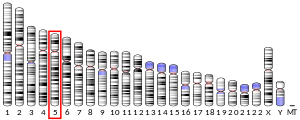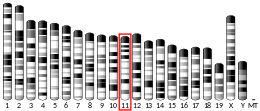PROP1
Homeobox protein prophet of PIT-1 is a protein that in humans is encoded by the PROP1 gene.[5][6]
PROP1 has both DNA-binding and transcriptional activation ability. Its expression leads to ontogenesis of pituitary gonadotropes, as well as somatotropes, lactotropes, and caudomedial thyrotropes. Inactivating mutations in PROP1 result in deficiencies of luteinizing hormone (LH; MIM 152780), follicle-stimulating hormone (FSH; MIM 136530), growth hormone (GH; MIM 139250), prolactin (PRL; MIM 176760), and thyroid-stimulating hormone (TSH; MIM 188540). See combined pituitary hormone deficiency (CPHD; MIM 262600).[supplied by OMIM][6]
References
- ENSG00000175325, ENSG00000274382 GRCh38: Ensembl release 89: ENSG00000280635, ENSG00000175325, ENSG00000274382 - Ensembl, May 2017
- GRCm38: Ensembl release 89: ENSMUSG00000044542 - Ensembl, May 2017
- "Human PubMed Reference:". National Center for Biotechnology Information, U.S. National Library of Medicine.
- "Mouse PubMed Reference:". National Center for Biotechnology Information, U.S. National Library of Medicine.
- Wu W, Cogan JD, Pfaffle RW, Dasen JS, Frisch H, O'Connell SM, Flynn SE, Brown MR, Mullis PE, Parks JS, Phillips JA III, Rosenfeld MG (Feb 1998). "Mutations in PROP1 cause familial combined pituitary hormone deficiency". Nat Genet. 18 (2): 147–9. doi:10.1038/ng0298-147. PMID 9462743.
- "Entrez Gene: PROP1 prophet of Pit1, paired-like homeodomain transcription factor".
Further reading
- Osorio MG, Kopp P, Marui S, et al. (2000). "Combined pituitary hormone deficiency caused by a novel mutation of a highly conserved residue (F88S) in the homeodomain of PROP-1". J. Clin. Endocrinol. Metab. 85 (8): 2779–85. doi:10.1210/jc.85.8.2779. PMID 10946881.
- Dasen JS, Rosenfeld MG (2001). "Signaling and transcriptional mechanisms in pituitary development". Annu. Rev. Neurosci. 24 (1): 327–55. doi:10.1146/annurev.neuro.24.1.327. PMID 11283314.
- Mody S, Brown MR, Parks JS (2003). "The spectrum of hypopituitarism caused by PROP1 mutations". Best Pract. Res. Clin. Endocrinol. Metab. 16 (3): 421–31. doi:10.1053/beem.2002.0218. PMID 12464226.
- Rodriguez R, Andersen B (2003). "Cellular determination in the anterior pituitary gland: PIT-1 and PROP-1 mutations as causes of human combined pituitary hormone deficiency". Minerva Endocrinol. 28 (2): 123–33. PMID 12717343.
- Fofanova O, Takamura N, Kinoshita E, et al. (1998). "Compound heterozygous deletion of the PROP-1 gene in children with combined pituitary hormone deficiency". J. Clin. Endocrinol. Metab. 83 (7): 2601–4. doi:10.1210/jc.83.7.2601. PMID 9661653.
- Amendt BA, Sutherland LB, Semina EV, Russo AF (1998). "The molecular basis of Rieger syndrome. Analysis of Pitx2 homeodomain protein activities". J. Biol. Chem. 273 (32): 20066–72. doi:10.1074/jbc.273.32.20066. PMID 9685346.
- Cogan JD, Wu W, Phillips JA, et al. (1998). "The PROP1 2-base pair deletion is a common cause of combined pituitary hormone deficiency" (PDF). J. Clin. Endocrinol. Metab. 83 (9): 3346–9. doi:10.1210/jc.83.9.3346. hdl:10400.17/2282. PMID 9745452.
- Flück C, Deladoey J, Rutishauser K, et al. (1998). "Phenotypic variability in familial combined pituitary hormone deficiency caused by a PROP1 gene mutation resulting in the substitution of Arg-->Cys at codon 120 (R120C)". J. Clin. Endocrinol. Metab. 83 (10): 3727–34. doi:10.1210/jc.83.10.3727. PMID 9768691.
- Duquesnoy P, Roy A, Dastot F, et al. (1998). "Human Prop-1: cloning, mapping, genomic structure. Mutations in familial combined pituitary hormone deficiency". FEBS Lett. 437 (3): 216–20. doi:10.1016/S0014-5793(98)01234-4. PMID 9824293.
- Rosenbloom AL, Almonte AS, Brown MR, et al. (1999). "Clinical and biochemical phenotype of familial anterior hypopituitarism from mutation of the PROP1 gene". J. Clin. Endocrinol. Metab. 84 (1): 50–7. doi:10.1210/jc.84.1.50. PMID 9920061.
- Mendonca BB, Osorio MG, Latronico AC, et al. (1999). "Longitudinal hormonal and pituitary imaging changes in two females with combined pituitary hormone deficiency due to deletion of A301,G302 in the PROP1 gene". J. Clin. Endocrinol. Metab. 84 (3): 942–5. doi:10.1210/jc.84.3.942. PMID 10084575.
- Nakamura Y, Usui T, Mizuta H, et al. (1999). "Characterization of Prophet of Pit-1 gene expression in normal pituitary and pituitary adenomas in humans". J. Clin. Endocrinol. Metab. 84 (4): 1414–9. doi:10.1210/jc.84.4.1414. PMID 10199788.
- Deladoëy J, Flück C, Büyükgebiz A, et al. (1999). ""Hot spot" in the PROP1 gene responsible for combined pituitary hormone deficiency". J. Clin. Endocrinol. Metab. 84 (5): 1645–50. doi:10.1210/jc.84.5.1645. PMID 10323394.
- Agarwal G, Bhatia V, Cook S, Thomas PQ (2001). "Adrenocorticotropin deficiency in combined pituitary hormone deficiency patients homozygous for a novel PROP1 deletion". J. Clin. Endocrinol. Metab. 85 (12): 4556–61. doi:10.1210/jc.85.12.4556. PMID 11134108.
- Vallette-Kasic S, Barlier A, Teinturier C, et al. (2001). "PROP1 gene screening in patients with multiple pituitary hormone deficiency reveals two sites of hypermutability and a high incidence of corticotroph deficiency". J. Clin. Endocrinol. Metab. 86 (9): 4529–35. doi:10.1210/jc.86.9.4529. PMID 11549703.
- Teinturier C, Vallette S, Adamsbaum C, et al. (2002). "Pseudotumor of the pituitary due to PROP-1 deletion". J. Pediatr. Endocrinol. Metab. 15 (1): 95–101. doi:10.1515/jpem.2002.15.1.95. PMID 11822586.
- Crone J, Pfäffle R, Stobbe H, et al. (2002). "Familial combined pituitary hormone deficiency caused by PROP-1 gene mutation. Growth patterns and MRI studies in untreated subjects". Horm. Res. 57 (3–4): 120–6. doi:10.1159/000057962. PMID 12006708.
External links
- GeneReviews/NCBI/NIH/UW entry on PROP1- Related Combined Pituitary Hormone Deficiency (CPHD)
- PROP1+protein,+human at the US National Library of Medicine Medical Subject Headings (MeSH)
This article incorporates text from the United States National Library of Medicine, which is in the public domain.
This article is issued from Wikipedia. The text is licensed under Creative Commons - Attribution - Sharealike. Additional terms may apply for the media files.




